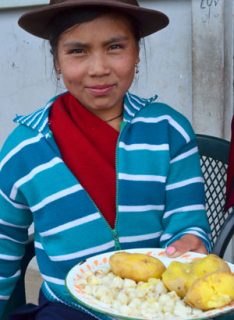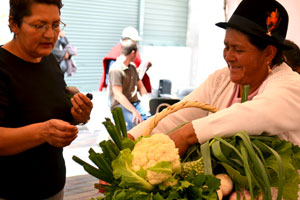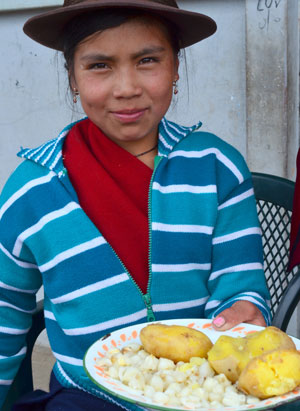In December 2012 Farming Matters ran an article about “Development 3.0”, highlighting the importance of showcasing peoples’ experiences as an inspiration for social change. The Canastas Comunitarias, a movement started by families to address their concerns over food prices (and presented in vol. 28.3 of our magazine) provides a clear example of this approach. Today, the movement has expanded to six cities in Ecuador and has diversified to address new concerns, but remains a perfect example of the benefits of local food systems.

Over several decades, intermediaries have acquired more and more power in influencing how urban families in Ecuador acquire their food. As part of this process, the urban population has progressively lost track of the different relationships and meanings generated through food procurement.
At the same time, agricultural production is less shaped by the local context and culture. The growing distance between producers and consumers means that consumers have lost touch with the farms or region where their food comes from, producers don’t know who will eat their products, and both groups are increasingly vulnerable to the interests of intermediaries.
The development of longer chains is a main characteristic of the modern food system. Consumers and producers do not know one another (and it is becoming increasingly difficult for them to know one another), farmers’ incomes are falling, consumers’ choices are limited, and diets are less varied and less healthy.
Based on a renewed relationship between producers to consumers, the concept of local food networks is becoming increasingly relevant. Various examples of direct access to markets, or of “shortcuts to commercialisation”, have emerged as a reaction to the growing power exerted by intermediaries and a handful of supermarkets, showing that families, when they organise, have the potential to change a difficult situation.
One of the best examples is that of the Canastas Comunitarias. These started in the 1980s as urban consumer groups, with members pooling funds to make bulk purchases, which are then divided among the families in the group, giving them substantial savings. Today, the Canastas Comunitarias are a national network of urban, lower class families who have crafted an alternative model that helps them save money, while providing access to quality food.
But what first started as a collective purchasing mechanism to save citizens money, slowly led participants to question the origins and ways in which the food they consume is produced. Many consumers openly started to question the value of saving money by buying food produced with chemical inputs. This encouraged them to approach farmers in search for answers and closer ties, helping the Canastas Comunitarias to become a tool to strengthen the relationship with producers.
Tzimbuto and Canasta Comunitaria Utopía

With approximately 250 inhabitants, Tzimbuto is a small, rural community located in the province of Chimborazo, in Ecuador’s central highlands. It is one of the areas where EkoRural, a local development organisation, had been supporting a farmer-led initiative.
Farmers have different plots spread throughout the area, where they grow a variety of crops. At an average altitude of 3,000 m above sea level, these plots contain various crops, medicinal plants and fruit trees, forming a mosaic of diversity.
At the beginning of 2010, the Asociación Nueva Generación, which is mostly made up of women from Tzimbuto, met the leaders of Canasta Comunitaria Utopía, one of Ecuador’s oldest canastas, which is based in the nearby city of Riobamba. Having previously worked with both groups, EkoRural saw the opportunity to bring together their complementary interests around food consumption and production, and facilitated the initial meetings. Our interest in building stronger consumer- producer relationships was mainly a response to the producers’ recurring preoccupation with their limited bargaining power, the low prices they received for their products, and the seemingly unjust benefits that families – both urban and rural – gave to intermediaries.
Three years later, around 50 farmers regularly deliver their products to the canasta, and these are taken to consumers in Riobamba. Today, the producers provide approximately 25% of the purchases made by the Canasta Utopía (and about 50% of the vegetables). The Tzimbuto farmers make an average profit rate of 80% – approximately twice what they make when selling the same products to the wholesale retailer. Their association is also stronger than before and they have put mechanisms in place to encourage other neighbours to join.
At the same time, the advantages for members of the canasta in Riobamba are clear: they pay half of what they would otherwise have to pay in the city supermarkets or retailers. The canasta pays the farmers in Tzimbuto the same that they paid to wholesalers in the past, but get better quality products (environmentally-friendly products, free from pesticides and other chemicals) for the same price.
Establishing linkages
While stronger links between consumers and producers give many advantages, building these new relationships is not always a straightforward process. We saw some initial difficulties because of the cultural differences between the rural and urban families, and some producers found it difficult to avoid the use of pesticides and other harmful production practices that they were used to. This created some difficulties when trying to co-ordinate the efforts of both parties, ensure the quality of all products, and build a trust-based relationship.
Yet all the participants found that working together for change opened up exciting new possibilities, starting with the identification of the relationships and reciprocities that had been lost, and which they all wanted to rebuild. Both groups wanted a good business deal; consumers also wanted to gain access to healthy food, while farmers were interested in knowing more about those eating their products, their tastes and preferences. Members of the Asociación began planning in detail what to grow and when, organising a more efficient way of providing the required products.
A process of produce diversification led to the introduction of new species and varieties, including indigenous potato varieties and crops such as mashua (Tropaeolum tuberosum), oca (Oxalis tuberosa), arracha (Arracacia xantorrhiza), and melloco (Ullucus tuberosus), all of which became gradually available for selling and consumption. In addition, farmers started paying more attention to their own farming practices, the clear advantages of crop rotations, associations, and the use of manure. Looking back, these practices have had a major impact on the availability of new foods for families in both Tzimbuto and Riobamba.
How to achieve all this was essential for a lasting change. The farmers agreed on the need to strengthen their own organisation and to assign clear roles and responsibilities within it. They also agreed to capitalise their organisation by giving back to the group twice as much as they receive from it (in the form of inputs, seeds and other materials). To guarantee the origin and quality of production, the association created a committee to oversee all operations, and named a community leader to ensure that the products meet the established criteria.
Without a doubt, the successes seen have been the result of the leadership efforts of farmer members like Elena Tenelema, and of the inspiration and motivation of Roberto Gortaire, Lupe Ruiz and all those behind the canastas. There is now a co-ordinated system of production and delivery in place which gives all members the opportunity of participating, and benefitting.
A force for change
The link between Canasta Comunitaria Utopia and Tzimbuto demonstrates that the creation of new, healthier relationships between urban and rural families has clear and direct benefits. These are not limited to the creation of a more stable market, better prices for farmers and better quality products for consumers.
Both groups have also learnt about the importance of a sustainable approach to agriculture, of having a strong organisation, about the role and contribution of volunteers, the need to plan and co-ordinate activities in detail, and also about quality – something that faceless consumers never demand. These efforts are showing how the commercialisation of farm products can become a major force for healthier living, with immediate (and highly positive) economic, social and environmental consequences. This is all even clearer when we take the true costs of modern food into account.
There is an enormous potential for strengthening such practices that are based on people’s inter-dependence and their endless creativity. The existing wealth that is already invested in food production and consumption can be used to strengthen urban and rural organisations. It can also help address the exclusion of certain sectors in our communities and societies and open up spaces for more pluralism and democracy, for example, by involving schools, hospitals, and community organisations. Eating is perhaps our most basic activity, but its potential as a tool for change has been neglected and forgotten. The resources are already in place. They just need to be re-invested and re-placed for new social purposes.
Ross M. Borja, Pedro Oyarzún, Sonia Zambrano and Francisco Lema
Ross Borja, Pedro Oyarzún, Sonia Zambrano and Francisco Lema work at Fundación EkoRural, Quito, Ecuador.
E-mail: rborja@ekorural.org
The authors acknowledge the valuable inputs of the leaders and members of both organisations, as well as their passion and commitment. They thank Carlos Perez and Claire Nicklin for their advice, and the McKnight Foundation for its support. The valuable comments of Jason Donovan of ICRAF and Steve Brescia of Groundswell International are also acknowledged.


